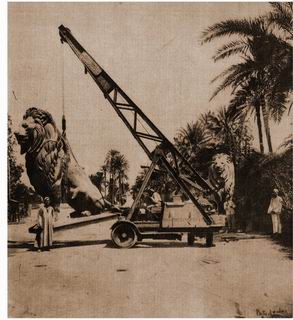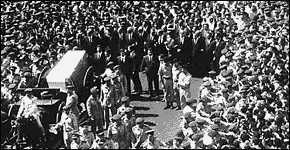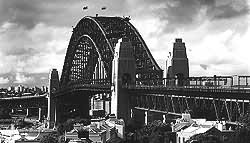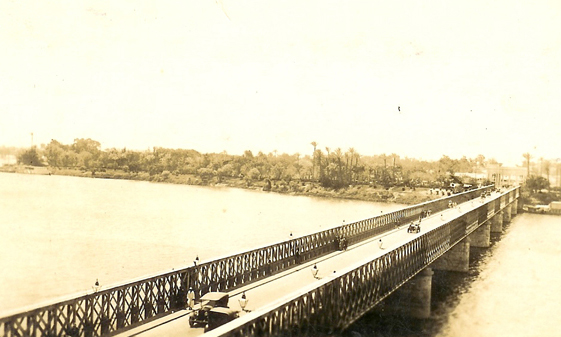The Story of Kasr El Nil Bridge
by Samir Raafat
Medina, November 2000
bridge nearing completion 1933 with old Semiramis hotel seen in background
|
|
|
|
|
Cheers to our "talented" literature prize awardee. Your pain his gain !!!
|
|
|
EGY.COM - ZAMALEK
|
|
by Samir Raafat
Medina, November 2000
bridge nearing completion 1933 with old Semiramis hotel seen in background
If you ask a connoisseur what Sydney Harbor Bridge and Kobri Kasr el Nil have in common he'll tell you they're both located within range of their city's opera house. Well yes, except that Down Under's celebrated bridge and opera house are potent symbols of Australia with world-landmark recognition status. Whereas both Egyptian counterparts, although worthy of particular credit cannot profess deserved acknowledgment from their own home crowd! Yet it wouldn't hurt to give the Kasr el Nil Bridge crossing credit for being the first in its league to span the world's longest river.
Ten time zones and hemispheres apart, the two bridges were inaugurated within 15 months from each other. The 503 meter-long Sydney Harbor Bridge on 19 March 1932 and the 1932 meter-long Kasr el Nil on 6 June 1933. Both bridges were constructed by Dorman, Long & Co. Limited of Middlesbrough, Yorkshire, UK.
Internationally renown for its steelwork constructions Dorman Long accounted for another famous bridge in Africa: Birchenough Arch Bridge above the Sabi River in what is today Zimbabwe.
Interesting also to know our handsome steel bridge was not always called Kasr el Nil and it certainly wasn't the first crossing to appear at that particular section of the Nile.
Between 1869-71, at a cost of LE 108,801, St. Simonian engineer Linant de Bellefonds had, with the participation of French steel makers Fives Lilles, strung what amounted to a narrow iron causeway across the Nile linking the very same embankments we are so familiar with today. The bridge departed just south of Princess Nazli's palace (later the infamous British-occupied Kasr el Nil Barracks) ending at the southern tip of the uninhabited island of Boulac commonly known today as Gezira-Zamalek. The bridge was opened to traffic in February 1872. These were the days when the French still had a say in Egypt's economy and when the crossing was unofficially referred to as Kobri el Gezira or Gezira Bridge.
The construction of Kasr el Nil Bridge served first and foremost as a catalyst for the development of Gezira Island and the expanse that lay beyond. It would unwittingly serve as the first nail in history's most celebrated skyline. Within a century from its building, the timeless vista of the 4,000 old Giza pyramids would no longer be seen from downtown Cairo. For sure the Gezira toll bridge came as a bane for traditional ferry operators and feluka owners, yet, on the other hand, pedestrians, camels, wagon-owners, donkey-carts and stagecoaches could now remain on terra firma all year round. Gone were the days when summer floods separated the Nile valley into two alien continents.
With the arrival of the horseless carriage the Egyptian Department of Public Works found it necessary in 1913 to commission Cleveland Bridge & Engineering Co. to give the aging crossing a badly needed facelift. In July of the same year floor boards reinforced with concrete blocks were added to the bridge and its narrow sidewalks widened. Gezira Bridge would thus have a new lease on life linking a city in perpetual effervescence to the still bucolic province of Giza.
By 1930 it became apparent that Bellefond's bridge had to go. With more than 31,000 all-category vehicles licensed in Egypt, cars were the norm not the exception. Bridge builders from all over the world were invited to submit their tenders.
Of the thirteen received by the Egyptian Roads and Bridges Department, only two made it to the final selection on January 1931. This time around Cleveland Co. lost out to its arch rival Dorman, Long & Co. represented in Egypt by Colonel Vivian Beaconsfield Gary of the Associated British Manufacturers (ABM) Egypt Limited.
With a LE 308,000 done deal tucked under its belt, Dorman, Long & Co.'s of London's 55 Broadway Street proceeded to establish an Egyptian bridgehead so to speak when it opened a temporary office at ABM's headquarters in the prestigious Khedivial Building (Bloc B) on Emad el Dine Street. Dorman, Long & Co.'s new telegraphic address: Dormbridge, Cairo. The local boss was one Mr. T. Biggart.
Once Barclays Bank had issued the appropriate letters of guarantees to the Egyptian government on behalf of Messrs. Dorman & it was simply a matter of hiring of competent foreign and local personnel.

lions relocated; inspection of bridge prior to completion
In January 1931 the four lions guarding Kasr El Nil Bridge were fittingly relocated at the Zoological Garden in Giza. Originally, the larger than life bronze lions created by French sculptor Alfred Jacquemart were meant to stand guard around Mohammed Ali's statue in Alexandria but Linant de Bellefonds thought better of it and brought them to Cairo instead. They could stand guard on his Nile opus.
For the next five months the old narrow bridge was dismantled. It was agreed the new, larger replacement would be placed along the identical alignment. The finest bridge builders of the day had exactly thirty months to come up with the product.
Like Sydney Harbor Bridge, most of the hardware and equipment was imported from Britain. But unlike the fixed Australian bridge, Cairo's new seven-span 382 m long arch-type steel crossing was designed so that a 67 m. section could swing open electrically within 3 ½ minutes.
Another Kasr el Nil challenge was the rebuilding of the foundations since the old ones were found to be unsafe. And in order to soften the overall aspect of the steel structure lampposts were introduced at given intervals. For the first time a Cairo bridge shimmered over the Nile like a bride on her wedding night.
Except for the two pairs of Aswan granite pylons at either end of the Kasr el Nil Bridge and those proud four lions there was little else was to remind Cairenes that an older bridge had once stood there. Nor was there a plaque mentioning 'here stood Cairo's first ever steel bridge designed by a Frenchman.'
Could it be that the Kasr el Nil lions remember their St. Simonian patron?
The eight-span bridge was constructed in a record 30 months. During this time, a daylight steam ferry service operated every half-hour between a pier situated below the Semiramis Hotel and an embankment south of the Pont des Anglais (renamed Evacuation Bridge-al Gala'a after 1956). Suggestions on what to do with the old Gezira Bridge poured in meanwhile. One worthy citizen recommended that it be reassembled in Luxor for the benefit of tourists wanting to cross the Nile. For an inexplicable reason or perhaps for ecological purposes the suggestion was mooted so that up until 1996 the Luxor crossing would be carried by felucca or ferry as it had been for the last seven recorded millenniums.
On 6 June 1933 at 10:00 King Fouad inaugurated the Nile's newest crossing. Understandably, the 20 meters wide bridge was christened Khedive Ismail Bridge in honor of the King's father. If you look carefully, the original name is still in evidence on the etched granite slabs located under the lion to your right as you enter the bridge. The name 'Khedive Ismail Bridge' is also marked in English on the Dorman & Long plaque attached to the belly of the bridge.
It was during the visionary reign of Ismail that the original bridge had been built linking the Khedive's then-budding metropolitan Cairo to a little know island he would render world famous during the Suez Canal opening celebrations.
To commemorate the inauguration of the new Kasr el Nil Bridge, Major F.W. Stephen representing Messrs. Dorman, & Long offered King Fouad a golden pen and inkstand in the shape of the new bridge. On hand at the ceremony held at the Gezira-end of the bridge were cabinet ministers, Egyptian and foreign notables as well as the accredited diplomatic corps.
Also present were members of the large British colony residing in the now fashionable suburbs of Zamalek and Garden City. They were especially pleased since the latest British-built addition to Cairo's skyline would considerably reduce the distance between downtown Cairo and the Gezira Sporting Club. The alternative was the cumbersome detour via Boulac Bridge and the dusty Boulac Avenue, both of which had been renamed Fouad al-Awal the previous year in honor of the reigning King.
A lesser event that took place that day behind the scenes was the official handing over of Kasr el Nil Bridge. Representing Messrs. Dorman & Long was T. Biggart. Representing the Roads & Bridges Department was Chief Inspector Gawdat standing in for Minister of Communications Karim Pasha. Accompanying him were senior civil engineers Selim Amoun Bey and Tahir el Sirgani. Both had played a leading role during the construction phase.
After careful examination the bridge was found to have been executed in accordance to the Cahier des Charges with some minor exceptions. For example, the lampposts absorbed rather than deflected light, which meant the glass had to be changed. Manhole covers and bridge footpaths needed adjustment.
Another exception had to do with "the insertion of plates in the clearance between the expansion plates and the abutments to prevent any washing-water from falling on the bridge terraces."
Shortly after the toppling of King Farouk in 1952 and the coming to an end of almost 70 years of British occupation name changes were introduced to some of Cairo's principal landmarks. King Fouad Bridge was renamed Abou El Ela Bridge in honor of a little known Sheik Hussein Abou el Ela whose shrine and mosque stood nearby. Equally important with regards to Cairo's modern history, Khedive Ismail Bridge reverted to its old but still familiar name of Kobri Kasr el Nil.
Meanwhile the palace of Kasr el Nil which had lent its name to the bridge and the surrounding section of Cairo disappeared in 1955 making way for the Arab League building and the Nile Hilton. The house of poet Kout el Koloub el Demerdashia that stood at the downtown entrance to the bridge was pulled down to make way for the ramp leading onto the bridge. The belle époque Semiramis that had seen both bridges was also pulled down in order to accommodate a newer glass and concrete hotel. The Nile floods that swelled the river almost to the level of Kasr el Nil Bridge ceased in 1970.
Many changes that Egypt's young population never witnessed. And the only ones who are there to tell the whole story are Cairo's most talked about lions. If only they could speak!
KASR EL NIL BRIDGE FACTOIDS
The bridge featured prominently on world television during President Gamal Abdel Nasser's state funeral in September 1970 when several dozen heads of state and governments marched across the bridge behind Nasser's coffin.

One of the most talked-about car accidents that took place on the bridge was that of royal cabinet advisor and sometime desert explorer and first ever Egyptian Olympic gold medallist (1912) Ahmed Hassanein Pasha on 19 February 1946. The accident triggered endless speculation of foul play ranging from a monarch seeking to put an end to wags linking his mother to the royal advisor, to Britain's MI-5 liquidating one of the most anti-British elements within the palace entourage.
Foundation stone of the new Kasr el Nil Bridge laid by King Fouad on 4 February 1931.
The design of Kasr el nil Bridge was prepared by the contractors' consulting engineers Mr. (later Sir) Ralph Freeman of Sir Douglas Fox & Partners, and Sir John Burnet & Partners. Ralph Freeman was also involved with the design of Sydney Harbor Bridge.

3,701 tons of steel manufactured in Middlesbrough Steel Works in Yorkshire were used for the bridge's construction.
Marble slabs used for the stairs leading down to the river at either end of the bridge were obtained from the quarries of Giza.
Masonry and granite work on the bridge including the four decorative pylons and statue pedestals was undertaken by A. Vescia Co. of Egypt.
The foundations for the seven piers carrying the full weight of six spans were dug to a depth of seven meters below the riverbed level and filled with special reinforced high-grade concrete. These were encases in Aswan granite.
The main British hardware purveyors were J.M. Henderson for the cranes; Ashmore Pease & Benson for the gauges and air locks; Leeds Engineering Co. for the hydraulic jacks; English Electric Co. for the generators; Clarke Chapman & Co. for the single cylinder steam winches; W.H. Wilcox & Co. for the hand plate-rolling machine; Chalmers Edina CO. for the Edina suction pumps.
Barges used for construction purposes provided by the Anglo-American Nile Company.
The bridge was laid out with compressed asphalt paving slabs from Val de Travers.
Up to the 1960s the bridge opened twice a day. Later it would only open to enable Nile cruise ships to pass.
The worse place to be in the days before the Nasr City Olympic Stadium was built, was on Kasr el Nil Bridge following and Ahli vs. Zamalek soccer game.
Topping the list of Cairo's favorite photo-ops are the Kasr el Nil lions. Similarly, the view and photo-ops from the bridge are second to none. It is an all year favorite backdrop for newlyweds. Ironically for several decades it was forbidden to take photos of Cairo bridges leading to the arrest of many an unsuspecting tourist.
The origins of the world 'kobri' meaning in Arabic is from the Turkish word 'kupru.'

Reader Comments |
Subject: Kasr el Nil bridge |
|
|
|
|